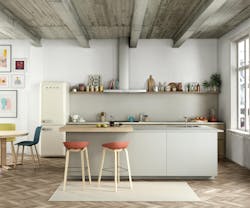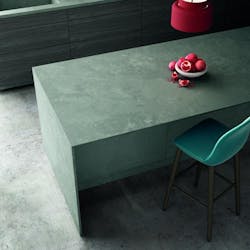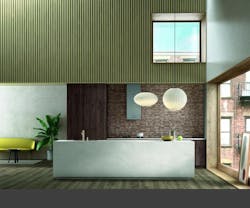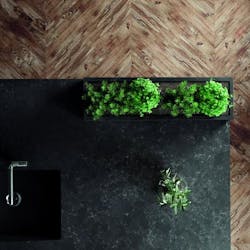Cosentino Releases New Eco-Friendly, Concrete-Like Quartz Surfacing
Quartz surface manufacturer Cosentino released its new Silestone Loft Collection last week, its first line created through the company’s new production process that heavily relies on reused materials.
Loft living features unfinished, raw, and exposed interior style, and Cosentino wanted to capture this in its latest surface collection. History, along with this industrial style, play a large role in the collection’s creation as well.
The five surfaces each appear to be similar to a cement countertop’s appearance, except in the much more practical, manufactured quartz material.
[ Read More: WHAT'S THE DIFFERENCE BETWEEN CERAMIC TILE AND PORCELAIN? ]
Seaport
“It is the connection between the past and the present that led us to the creation of the Silestone Loft Series,” says Valentin Tijeras Garcia, product and research and development corporate director for Cosentino Group. “To capture the essence and energy of this mid-20th century industrial style, we studied the architectural bones and textures of abandoned factories. It’s that same deliberately unfinished look of concrete, cement, beams and pipes have been embraced in homes today and evolved into a leading design trend.”
Each surface is a result of Silestone HybriQ+ technology, the latest manufacturing process from Cosentino that uses reused raw materials, 98% recycled water, and 100% renewable energy. Reused raw materials include glass and allows for the minimization of crystalline silica in the production process. Though the production of this collection differs from others, the company says quality is not sacrificed and its 25 year warranty remains.
“The launch of Silestone HybriQ+ extends beyond Cosentino’s commitment to innovation and sustainability,” says Eduardo Cosentino, CEO of Cosentino North America and SVP of Global Sales. “This truly changes the entire paradigm of the quartz category. By reducing the presence of quartz in these new Silestone colors, our hope is that this advancement fuels industry-wide regulation changes requiring a decreased use of silica.”
[ Read More: NEED TO FIND AFFORDABLE COUNTERTOPS? THESE SIX STRATEGIES WILL HELP ]
Nolita
Five different colorways are available from the Loft Collection and each one takes its inspiration from an urban area around the world.
Camden gets its name from a London neighborhood known for its lively art scene and diversity. It can be seen as cement’s little, more manufactured, sister. Camden features a cement-like appearance with soft gray and a fine grain of black.
Poblenou’s name comes from Barcelona’s industrial revolution epicenter, Cosentino says. It’s a more diverse surface than Camden, as Poblenou offers a sand-like base with varying shades of a warmer gray. The sandy base can add a sense of texture and depth.
[ Read More: WALKER ZANGER INTRODUCES TILE COLLECTION MADE FROM RECYCLED MATERIAL, LOCALLY SOURCED CLAY ]
Corktown
Seaport, based off the area in Lower Manhattan, has a design much like a dark, looming rain cloud. Cosentino relates Seaport to a dark, worn cement. Its subtle streaks of white add a liquid-like effect.
Nolita is yet another New York City-inspired shade and could be seen as the inversion of Seaport. Instead of the gloomy grays from the rest of the Loft family, Nolita features bright whites mixed in with warmer, lighter shades of gray.
And if Nolita lives on one end of the Loft Collection’s spectrum, Corktown emerges at the other end. Corktown’s deep matte black finish is penetrated by lighter grays swirled around.



